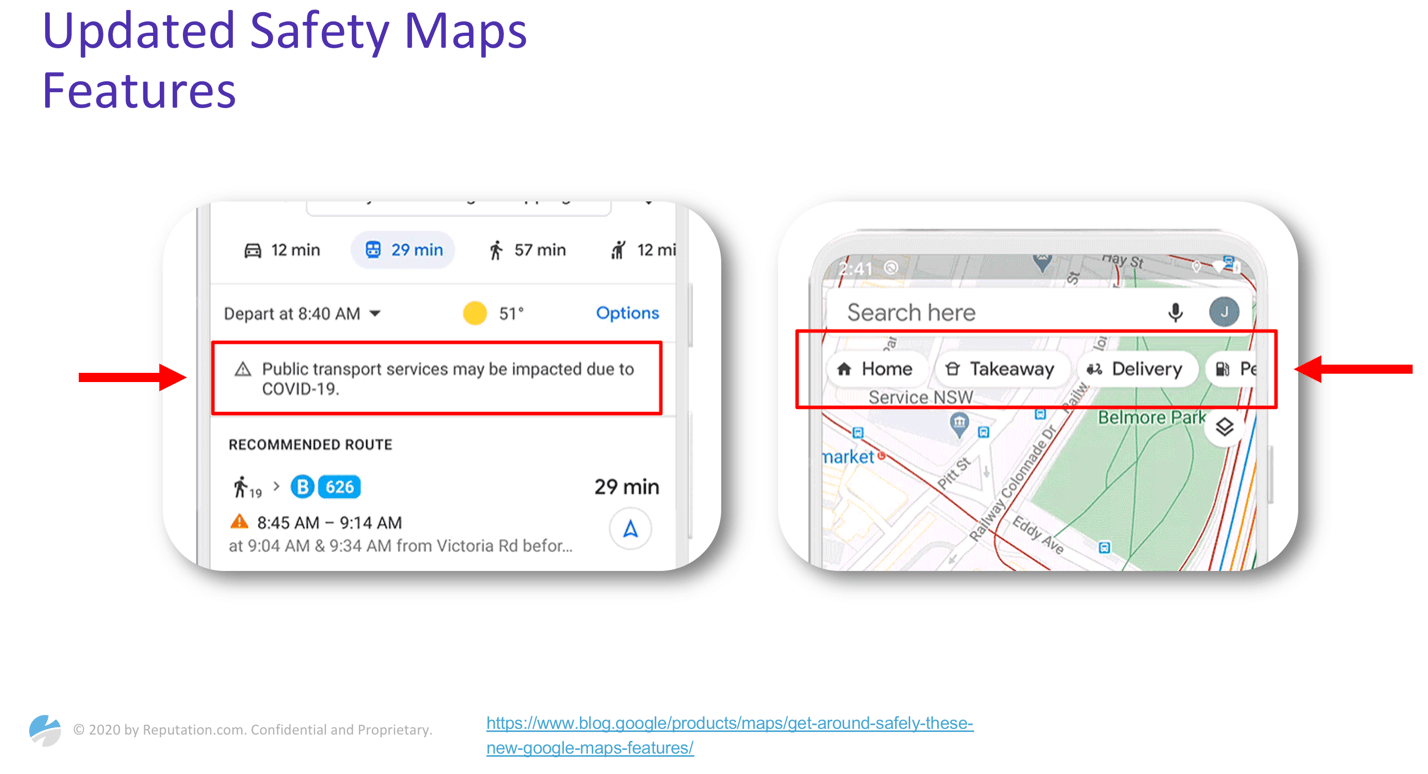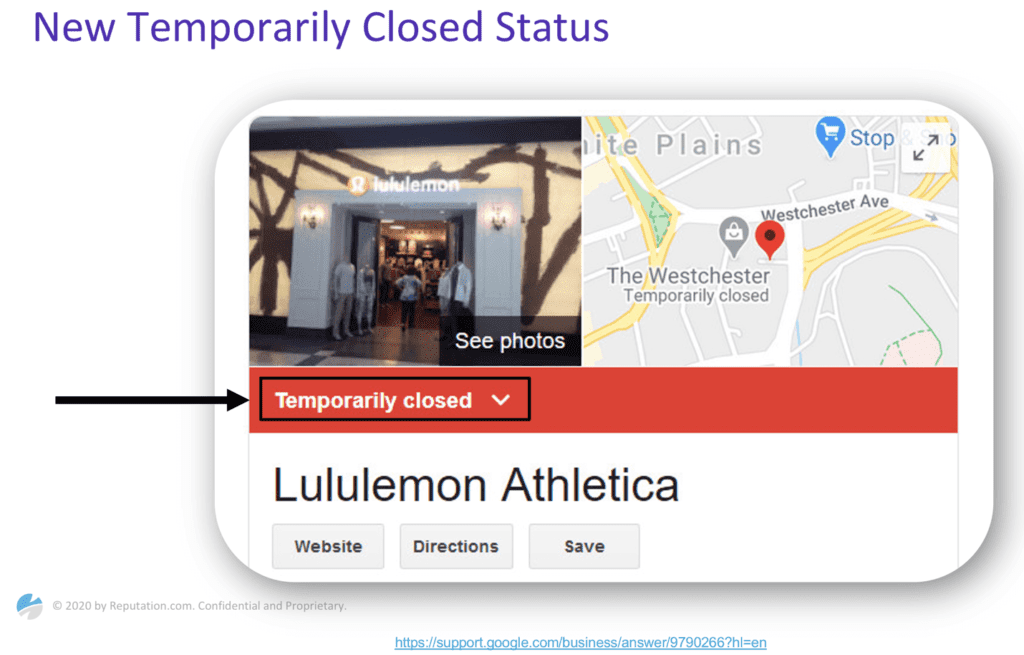So long as the COVID-19 pandemic remains in our lives, brick-and-mortar businesses will experience a roller coaster of re-openings, temporary closures, victories and setbacks. Along the way, it’s clear that they’ll need to monitor their Google My Business (GMB) listings closely to protect their reputations. In recent months, we’ve seen Google launch several features designed to help businesses react to the pandemic by updating their GMBs with relevant information that affects their operations. Let’s take a closer look at those features and how businesses should view them.
Temporarily closed

The introduction of a Temporarily Closed feature made it possible for businesses to make the distinction between a permanent closure and a temporary one, as with the case of COVID-19. Businesses had been needing a way to mark temporary location closures before the pandemic hit, an example being a seasonal business that closes for the winter. The pandemic caused Google to respond to this much-needed feature. It’s likely that Temporarily Closed is here to stay. Of course, businesses should use this feature if the pandemic causes another temporary closure, but consider its use for other times when your location is closed, as noted above.
Google Post chain restrictions removed
The Google Posts feature – technically known as Posts with Google – makes it possible for organizations with GMB listings to update their knowledge panels with dynamic content, such as special events, changes in hours, special offers, or the opening of a new location. Historically, Google has not allowed chains (businesses with more than 10 locations) to publish Google posts automatically across multiple locations. But as the pandemic took hold, Google lifted that restriction to make it easier for businesses with multiple locations to respond to customers with critical updates. I recommend that you take advantage of this feature while it lasts. Use Posts wisely to promote holiday sales, promotions, and special events, while informing customers about protocols you are following to permit these onsite activities safely. At some point, I believe Google will reinstate the chain restrictions.
New COVID-19 post type

This COVID-19 Post Type enables a business to post content about COVID-19 and make that post appear prominently on your GMB. When it’s posted, it is labeled specifically as COVID-19 related information affecting your business. Such posts always appear more prominently than others. So let’s say on a Monday you share a COVID-19 Post Type and then on Tuesday you use Google Posts to share a standard offer. The COVID-19 Post Type will appear above your standard Post. Obviously the COVID-19 Post Type will remain so long as the pandemic disrupts our lives. Continue to use it to your advantage – for example to highlight that your location offers COVID-19 testing services. But remember to delete the COVID-19 Post Type when it no longer serves your needs.
New GMB attributes and displays
Google added new attributes for businesses to add curbside pickup and no-contact delivery, which have been essential for restaurants and retailers. What interests me especially is how they are being displayed – very prominently in your knowledge panel. Not only are those attributes above the fold, but Google notes their existence with a check-mark or X that makes the attribute even more visible. If these attributes are available to you, it’s critical that you use them. And make sure they are accurate. It’s likely that these attributes will be permanent especially as curbside pickup becomes more popular among large chains. More like these will likely appear for other industries, too.
Local Service Ad attribute updates

Service area businesses, such as plumbers and home maintenance businesses have special requirements. For instance, they need to make it clear to their customers how they’ll protect their health while visiting homes. Fortunately, Google has addressed their needs with a local service ad attribute that makes it possible for businesses to share this kind of essential information. If you make use of Local Service Ads, capitalize on these attributes to reassure your customers that they can trust you to respect their health and safety.
Telehealth and COVID-19 links
My company works with many healthcare systems, and in March, one of the first things they told us was, “We need to stop people from coming to our locations and emergency centers unless they absolutely have to do so.” Of course, that’s because visiting a hospital during a pandemic creates a health risk. Fortunately, Google responded to this need by allowing healthcare systems to share on their GMBs prominent links to online care options and to information about getting information about COVID-19 without needing to visit a medical facility. These options have provided some relief to already beleaguered healthcare systems. If you are one of them, you absolutely need to put these features to work for you.
Support and donation links

Google has allowed businesses to post information how their communities can support them such as buying a gift card or making a donation. These options will most certainly remain for the foreseeable future as brick-and-mortar businesses fight through a recessionary economy. Although retail sales have rebounded after a disastrous March and April, brick-and-mortar businesses are going to continue to experience hard times especially if states reinstate shelter-in-place mandates. Don’t be shy about using support links. You need your communities more than ever, and your customers are willing to help however they can.
Secondary hours

Businesses that offer special hours of operation have lacked a way to publish those secondary hours on their GMBs. But as COVID-19 took hold, Google stepped up. In recent weeks, Google has support the publishing of secondary hours. An example is a grocery store adapting its hours of operation to accommodate people with special needs, such as retailers offering an hour each day exclusively for seniors to shop.
This feature isn’t going away. Too many businesses had been asking for the feature before 2020 especially as large, big-box stores accommodate special hours for multiple hours.
Updated safety maps features

Google has revised Google Maps to help people use the app to find routes and times that will make travel safer, an example being a recommended commuter train or driving route that avoids crowds. The safety feature also focuses on people traveling to COVID-19 testing sites: Google Maps now includes an alert reminding people to verify eligibility and facility guidelines to avoid being turned away or causing additional strain on the local healthcare system.
If you are a business owner in an urban environment, let your customers know about this feature in order to encourage customers to travel to your business. If you provide a testing facility, make sure you use the features discussed here to communicate eligibility and facility guidelines, as your visitors might check out your GMB listing after being prompted by Google.
Visual content on your GMB
As you use these COVID-19-related features, don’t overlook one of the most important GMB features: visual content. Video and images speak the language of our visual age, and for some time, Google has provided the ability for businesses to upload such content on your GMBs. It’s super important that businesses update your images to:
- Literally show your safety protocols, such as employees wearing masks and gloves.
- Show what it looks like for customers to do business with you now – such as images of customers using marked spaces to practice social distancing while standing in line at the check-out lane, or customers in restaurants seated six feet apart.
- Humanize your business with smiling, welcoming faces. A warm smile shines through a mask!
- Consider video to give customers a tour of your facility, showing them how your location is configured to provide a safe, pleasant shopping experience.
It boggles the mind to consider that in July, we are only one month into the second half of the most tumultuous year in recent history. A long road of recovery awaits. Businesses need to capitalize on every tool to make it to the other side. The good news is that your customers are paying attention to your GMBs. Our own company research shows that GMB views and clicks have rebounded. People want to do business with you and are using your GMB listing to do that. Make sure you manage their expectations and support your own business.
The post How 9 major Google My Business updates in 2020 can help you rebound appeared first on Search Engine Land.
Source: IAB

